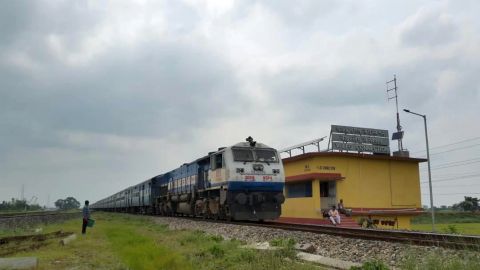The Western Railway had many obscure metre gauge and narrow gauge lines in Gujarat. Many have now been closed or converted to broad gauge. One of the more obscure ones was Victor on the southern coast of Saurashtra. This is what appeared in the 1975 timetables

The two terminals shown here are Rajula City and Victor, connected to the junctions Rajula Jn and Dungar respectively. Rajula City had three daily pairs of trains, while Victor has one pair of trains on 4 days of the week.
Going back to 1944:

Here we see the station listed as Port Albert Victor. It has a train only on two days of the week. At least we now have a clue as to its history. It can also be seen that the line to this terminal was opened in 1928.
But who was Albert Victor? You would have heard of Queen Victoria, but there was no British monarch called Victor. Maybe we have to go down the ladder a bit.
Prince Albert Victor was born in 1864. He was the eldest son of the future King Edward VII, who was then heir to the throne. Queen Victoria was the ruler, and would continue to be on the throne until 1901.
A younger brother (who later became King George V) was born in 1865.
Prince Albert Victor suffered from poor health in his childhood and did not seem to have done anything worth noting.
In 1889, he was sent to tour India for several months from October 1889 to May 1890. Wikipedia sums this up:
“The foreign press suggested that Albert Victor was sent on a seven-month tour of British India from October 1889 to avoid the gossip which swept London society in the wake of the scandal.[54] This is not true;[55] the trip had actually been planned since the spring.[56] Travelling via Athens, Port Said, Cairo and Aden, Albert Victor arrived in Bombay on 9 November 1889.[57] He was entertained sumptuously in Hyderabad by the Nizam,[58] and elsewhere by many other maharajahs.[59] In Bangalore he laid the foundation stone of the Glass House at the Lalbagh Botanical Gardens on 30 November 1889. He spent Christmas at Mandalay and the New Year at Calcutta. Most of the extensive travelling was done by train,[60] although elephants were ridden as part of ceremonies.[61] In the style of the time, a great many animals were shot for sport.[62] “
Presumably, the port in Gujarat was named after him during or soon after his tour.
However, he died of typhoid in 1892, when his grandmother Victoria was still the ruler and his father was still the heir apparent. His father ruled as King Edward VII from 1901 to 1910, while King George V (born in 1865) ruled from 1910 to 1936.
However, if Prince Albert Victor had lived beyond 1910 the entire line of succession would have changed. Perhaps the persons now known as Queen Elizabeth II and King Charles III would not have become monarchs.
During George V’s rule the rail link from Dungar to Port Albert Victor was opened in 1928. As we have seen, it did not seem to generate much passenger traffic. Today the line appears to have been abandoned.
Meanwhile, a new port came up at Pipavav to the south of Rajula City. This is one of the success stories of Indian ports today. It is unclear if Victor port will be revived.
https://en.wikipedia.org/wiki/Port_Pipavav
More about his visit to India:https://www.deccanherald.com/content/248794/a-road-named-princes-visit.html


















